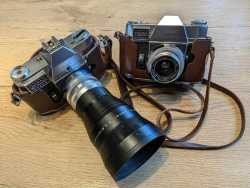>>4433315B&w is a good place to start. I used to do stand dev for a long time, but I suggest avoiding it. I use a rotary developer now, which is just as lazy, but much much faster dev times and greater control than stand. The results from stand dev are only okay, and you lose out on a large part of developing at home, actually learning how to control dev for contrast and highlights.
If you plan on doing rodinal stand dev expect quite grainy negatives with a low contrast. Easy to scan, but they can produce pretty flat looking prints that can be tricky to brung back to life.
I want more people to try pyrocat HD, so I will suggest(shill) you try it as your second developer. It is slightly more complex because it is a 2 part developer, and you may have to mix everything from pre measured dry chemicals. You add solution A to water, then solution B, generally around a 1+1+100 ratio. It can be cheaper than rodinal and it produces very very nice and small grain results with the ability of excellent contrast control.
It is also a staining developer, so it adds a mask to your negatives that make them print easier, usually.. I did the math and it's about 12 dollars for 100L of working solution if you buy the raw chemicals and mix it yourself. Last for 1 year after mixing.
The leader retrieval tool can be useful if your camera auto rewinds. You should open the can up and pull the film out before loading to avoid scratching your film. Bottle openers work well or you can just pry them open by hand pretty easily.

